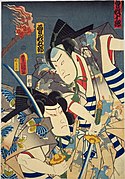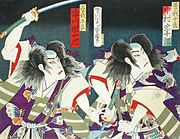Soga Sukenari
Soga Sukenari 曾我祐成 | |
|---|---|
 Eiyū Sanjyūrokkasen: Soga Jyūrō by Toshihide Migita | |
| Born | 1172 |
| Died | 28 June 1193 |
| Nationality | Japanese |
| Other names | Jyūrō, Ichiman |
| Occupation | samurai |
Soga Sukenari (Japanese: 曾我祐成, 1172 - June 28, 1193) was a samurai in the early Kamakura period. He is known for his participation in the incident known as the Revenge of the Soga Brothers. He is also known as Soga Jyūrō.
Life
Kawazu Ichiman was born in 1172 as the son of Kawazu Sukeyasu.
In 1176, when Ichiman was four years old, his biological father, Kawazu Sukeyasu, was killed by Kudō Suketsune, who accidentally killed him when he attempted to assassinate Itō Sukechika. Suketsune and Sukechika had been quarreling over the inheritance of land. After that, Ichiman's mother remarried to Soga Sukenobu, the lord of Soga Manor in Sagami Province (currently Odawara, Kanagawa Prefecture), who became Ichiman's stepfather.[1] Shortly after Sukenobu becoming his stepfather, Ichiman had his coming-of-age ceremony (genpuku) with Sukenobu as his guardian (eboshi-oya). Ichiman received the imina name Sukenari, having Sukenobu bestow the kanji "suke" (祐) in his name upon him.[2] Sukenari, along with his younger brother Hako'ō (later Tokimune), are said to have mourned for their biological father.[3]
The Soga brothers, grandsons of Sukechika, had a difficult upbringing, and, as the elder brother, Sukenari took over the Soga family.[3] Later, Sukenari lived under the protection of Hōjō Tokimasa, his uncle by marriage whose late wife was the daughter of Sukechika.[3][3] Tokimasa would be the greatest supporter of the Soga brothers in the midst of their hardships, and the Soga brothers never forgot their father's vengeance.[3]

In June 1193, Sukenari, Tokimune, and their father's killer Suketsune, participated in the shogun Minamoto no Yoritomo's grand hunting event, called the Fuji no Makigari, at the foot of Mount Fuji. On June 28, 1193, the last night of the Fuji no Makigari, Sukenari and Suketoki fulfilled their vow and killed Suketsune. After the brothers killed ten other participants, Sukenari was shot by Suketsune's subordinate Nitta Tadatsune. Tokimune proceeded to raid into the shoguns living quarters attempting to assassinate the shogun, but was taken down by Gosho no Gorōmaru. Tokimune was executed the next day at the request of Suketsune's son, Itō Suketoki.[4]
After the incident, Sukenari's concubine, a prostitute named Tora, was interrogated but was later released because she found innocent of any involvement. In Hakone, she held a memorial service for Sukenari and sacrificed a grey horse that Sukenari had given her. She then left home for Zenkō-ji in Shina Province. The youngest brother of Sukenari was invited to Kamakura and joined the elder brothers in death by committing suicide by hanging. A biological brother of the Soga brothers, Hara Kojirō, was executed for this incident as a collective punishment for Minamoto no Noriyori losing his position and due to his connection to the incident.[4]

Genealogy
Through his father, Kawazu Sukeyasu, the eldest son of Itō Sukechika,[5] Sukenari descends from the Itō clan, a branch of the Kudō clan, and ultimately the Fujiwara clan.[6]
Through his mother's marriage, Sukenari is related to the Soga clan that has its origins are in the Soga Manor in Sagami Province. They descended from the Kanmu Heishi line of the Taira clan through the Chiba clan, making them direct descendants of the 8th century Emperor Kanmu.[7]
In popular culture
Theater
Soga Sukenari appears in noh and kabuki "Sogamono" (曽我もの) theater that is based on the Revenge of the Soga Brothers incident.
- "Soga Kyōgen" (曽我狂言) is a story about the Revenge of Soga brothers.[8]
- "Soga Moyōtateshi no Gosho-zome" (曽我綉侠御所染) is a story about the Soga brothers and the protagonist Gosho no Gorozō.[9]
Art
Soga Sukenari has been the subject of several ukiyo-e paintings. The most famous include the following:
- Soga Gorō and Soga Jyūrō (1860) by Utagawa Kunisada
- Dai Nihon Meisho Kagami; Tokyo Kaika Kyoga Meisho; Kokoku Nijushiko; Shinryu Nijushi Toki: Soga Gorō and Soga Jyūrō by Tsukioka Yoshitoshi
Gallery
-
Soga Gorō and Soga Jyūrō by Utagawa Kunisada
-
Soga Gorō and Soga Jyūrō by Tsukioka Yoshitoshi
-
Moor at the Foot of Mt Fuji- Soga Brothers Achieving their Avowed Wish by Utagawa Kuniyoshi
-
Soga Sukenari and Tokimune with Tegoshi no Sukuna by Utagawa Kunisada
See also
References
- ^ Aoki, Akira (1987). Manabon Soga Monogatari 1 (真名本曾我物語 1). Japan: Heibonsha. p. 253. ISBN 9784582804683.
- ^ Aoki, Akira (1987). Mana Hon Soga Monogatari 1 (真名本曾我物語1). The Oriental Library 468. p. 253. ISBN 9784582804683.
- ^ a b c d e Ichiko, Teiji (1966). Soga Monogatari - Iwanami Koten Bungakutaikei 88 (曽我物語 岩波古典文学大系88). Japan: Iwanami Shoten.
- ^ a b Sakai, Koichi (2000). Soga Monogatari no shijitsu to kyokou (曽我物語の史実と虛構). Japan: Yoshikawa Koubunkan. pp. 117–118. ISBN 4-642-05507-X. OCLC 675757532.
- ^ Daijisen. Akira Matsumura, 松村明, Shōgakkan. "Daijisen" Henshūbu, 小学館. 「大辞泉」編集部. (Dai 1-han ed.). Tōkyō: Shōgakkan. 1995. Kawazu Sukeyasu (河津祐泰). ISBN 4-09-501211-0. OCLC 34170147.
{{cite book}}: CS1 maint: others (link) - ^ Daijisen. Akira Matsumura, 松村明, Shōgakkan. "Daijisen" Henshūbu, 小学館. 「大辞泉」編集部. (Dai 1-han ed.). Tōkyō: Shōgakkan. 1995. Itō Sukechika (伊東祐親). ISBN 4-09-501211-0. OCLC 34170147.
{{cite book}}: CS1 maint: others (link) - ^ Sekai Daihyakkajiten 2 (世界大百科事典 第2版). Heibonsha. 1998. Soga-uji (曾我氏).
- ^ Matsumura, Akira (1995). Daijisen (大辞泉). Shogakukan. Soga Kyogen (曽我狂言).
- ^ Encyclopedia Nipponica (日本大百科全書). Shogakukan. 1998. Soga Moyōtateshi no Gosho-zome (曽我綉侠御所染). ISBN 4-09-906721-1.



